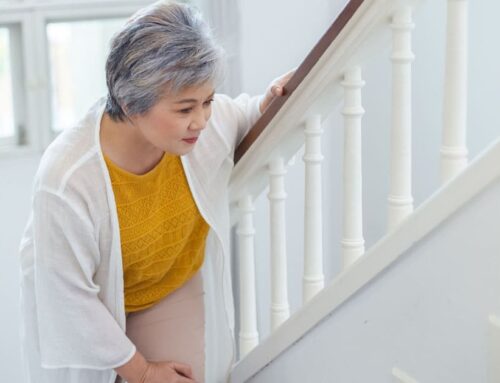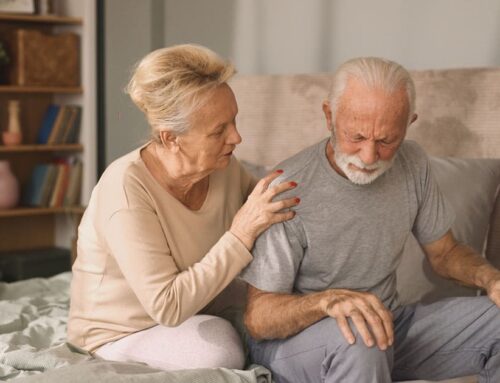For family members of an older adult, it’s crucial to recognize the signs of a stroke. A timely response can be life-changing and lifesaving. As a significant health concern, families and friends should familiarize themselves with the signs of stroke, what it is and steps to be taken immediately. These efforts can greatly influence the impact on a loved one’s health and may help reduce other complications or damage to the brain.
What is a stroke?
When the blood supply to part of the brain is interrupted or reduced, a stroke can occur and prevent brain tissue from getting oxygen and nutrients. There are two types of stroke – an ischemic stroke, which results from the blood supply being blocked and a hemorrhagic stroke, which occurs from bleeding in the brain.
The effects of a stroke can be devastating, leading to long-term disability or even death. Because of the severe effects and the benefits from a quick response, the more educated family members become about the signs of a stroke, the better likelihood they will be able to help a loved one if this occurs while they’re present.
Risk factors of a stroke
Several factors can increase the risk of stroke. Understanding these elements and the steps to take to better monitor and manage these health conditions can help minimize risk.
Risk factors can include:
- Age
- High blood pressure
- Diabetes
- Heart disease
- Smoking
- Family history of stroke
- Poor diet and little exercise
Encourage your loved ones to lead a healthy lifestyle, manage their medical conditions and have regular check-ups. Even small changes in diet, exercise and medication management can significantly affect risk factors.
Download our complimentary Memory Care Guide to learn more.
Signs of stroke
One of the easiest ways to remember what to look for as the key signs of a stroke is the acronym F.A.S.T.
- Face Drooping: Does one side of the face droop or is it numb? Ask your parent to smile. Is the smile uneven or lopsided?
- Arm Weakness: Is one arm weak or numb? Ask your parent to raise both arms. Does one arm drift downward?
- Speech Difficulty: Is the speech slurred or hard to understand? Ask your parent to repeat a simple sentence. Are they unable to speak or hard to understand?
- Time to Call 9-1-1: If your parent shows any of these symptoms, even if they disappear, call 9-1-1 immediately and get them to a hospital.
Additional signs of stroke can include sudden numbness or weakness in the legs, confusion, trouble seeing in one or both eyes, difficulty walking, dizziness, loss of balance, or severe headache with no known cause.
Take immediate action if signs of stroke are evident
The sooner help is available, the better chance of a recovery. Knowing the signs of stroke will allow you to take action quickly. Any delay in treatment can result in more brain cells dying.
It’s also essential to provide accurate and well-defined information when calling emergency services, including a clear description of the symptoms and when they started.
Post-stroke care
Recovery from a stroke can be a long process and may require physical therapy, occupational therapy, speech therapy and medication. If you’re a part of the caregiving team, your role will be vital in helping your loved one recover.
Educate yourself about post-stroke care and rehabilitation so you can better understand the effects of stroke and what is involved in the recovery. You will also want to learn how to manage a loved one’s emotional and mental health, as depression can be common after a stroke.
While caring for a parent who has had a stroke can be challenging, there is help available. You don’t need to travel this road alone. Seek support from health professionals, stroke support groups and community resources.
The role an assisted living community can play
Families often turn to an assisted living community to provide the level of care needed for someone who has recently had a stroke. They can also support the family to set realistic expectations and learn how the recovery process works.
People who are discharged from the hospital after a stroke may still need medical care or therapy before they’re ready to go back home, especially if they live alone. Many assisted living communities offer short-term rehabilitative care, including meals, personal care assistance and physical or occupational therapies.
Families may discover that the assisted living community also offers their loved one the opportunity to live a higher quality of life – even beyond the rehabilitation period. It’s not uncommon to choose to continue community living as a long-term option because residents enjoy healthy dining, opportunities to meet and make new friends and participate in activities and wellness programs. This is in addition to living an independent life in an accessible residence and having the services of a well-trained and compassionate staff available daily.
The Charleston Senior Living Community
Locally owned and operated, we offer personalized care by our dedicated team members. Setting a new standard in Assisted Living and Memory Care, we don’t define our residents by their limitations or illness but instead believe in focusing on the positive and the possibility.
The Charleston Senior Community includes private apartments for assisted living residents and for those living with Alzheimer’s or dementia. Your loved ones will benefit from our attention to detail, routine health assessments, delicious dining and daily activity programs as we support everyone to live their best life.
Consider a few of our amenities:
- Chef-led dining program
- Community movie theater
- Salon
- Ballroom
- Live entertainment
- Outdoor patio
- Social lounges
- Housekeeping
If you or your family is thinking about Assisted living or Memory care, we hope you will consider The Charleston Senior Community. We are a trusted resource and are here to answer any questions, contact us today.
We also invite you to download our complimentary Memory Care Guide to learn more about this type of senior living.









